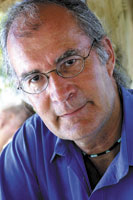Exposure & Processing Changes
There are profound changes occurring on the exposure side of photography that will cause many of us to rethink how we read, and even approach light. As you know, contrast has always been the problem, one more or less attacked with the Zone System (exposure and development to place tonal values) and even slight overexposure of color negative film, where dye clouds rather than silver could be extended to raise shadow detail. Slide shooters know well of what I speak. When digital came on the scene the problem was clearly overexposure, where excessive light in highlights was literally spilled off from the photo sites.
 The first stab at solving the digital contrast dilemma was HDR, which we have had for a few years now, where multiple exposures are made and then either tone mapped or layered to combine over- and underexposed (or at least exposed to saturate highlights) frames of the same scene. This required fairly close alignment, which meant that most HDR users were tethered to a tripod, or had to shoot quite fast and very steadily to make sure that frames lined up, followed up by intense image processing, with Photomatix Pro being recognized as one of the best routes to follow.
The first stab at solving the digital contrast dilemma was HDR, which we have had for a few years now, where multiple exposures are made and then either tone mapped or layered to combine over- and underexposed (or at least exposed to saturate highlights) frames of the same scene. This required fairly close alignment, which meant that most HDR users were tethered to a tripod, or had to shoot quite fast and very steadily to make sure that frames lined up, followed up by intense image processing, with Photomatix Pro being recognized as one of the best routes to follow.
Digital camera designers, or at least the software side of the team, then came up with tonal curve compensation in camera, which usually suppressed the highlight end of the curve or raised the shadow detail side. We first saw this in D-Lighting from Nikon, but that has been quickly added to with new developments, including Sony’s rather amazing DRO (Dynamic Range Optimization), which allowed for various “strengths” of curve adjustment. Having tested this I can attest to how effective it can be for overcoming problems that have plagued photographers since, well, the beginning of putting nature’s light on paper or film.
The latest stage in this development is again from Sony in their in camera HDR, which I recently worked with and will report on in an upcoming issue. You can set various strengths and set the camera for HDR, and then one press of the shutter release gets you two exposures, which combine over- and underexposure (by under I mean saturating the highlights so if they’re bright the rest of the values are necessarily underexposed). While we have seen variations on this in the past, notably in Fujifilm’s cameras, the results from this processing setup are impressive indeed.
The point is that we are fast approaching a time when many of the limitations of exposure and consequent contrast are being taken away, all by processing systems that resolve the issues that have limited our photography in the past. True, you still have to take the time to set these processing systems up, and make good light readings to start with, but pretty soon we will be able to move past many technical problems and take the time to consider light and how it affects our images.
Does this mean we can just push the button and let the camera do the rest? No, but it certainly means we can take more time considering what we shoot rather than be concerned by how the camera and our eye “see” differently and adjust exposure accordingly. Some folks might argue that we are quickly ceding our photographic eye to a machine. But being able to resolve contrast issues, shoot in ever lower light levels, and create images never before possible just means that our photography can become even more creative in that we can spend more time seeing and capturing our vision than fretting about settings to make up for the limitations of the medium. And those limitations are fast falling away.


































